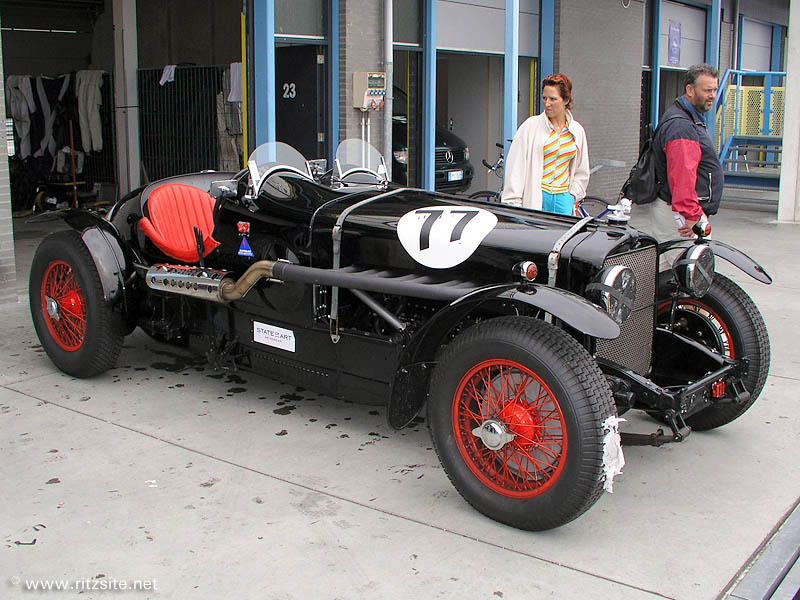|

Stutz Blackhawk Le Mans - speedster body by Weymann - manufactured in 1929
The Stutz company from Indianapolis in the US had its roots firmly planted in autosport. Its first car was entered in the 1911 Indianapolis 500 mile race and enjoyed a creditable 11th place finish and the famous Bearcat models that followed left an impressive mark on American racing history. The company's history had its ups and downs and ended, sadly stricken by the great depression, undeserved in 1935.
Stutz is mostly remembered by the Bearcat, a pure masculine racing car reduced to the bare essentials and almost without any comfort, which is a bit unjustified because the cars produced during the last period of the marque's history were high quality luxury cars which competed with cars from Cadillac, Lincoln and alike in the marketplace. The man primarily responsible for that was Frederick Moskovics who became president of the Stutz company in 1925 and was intent on transforming Stutz cars from uncompromising sports cars to elegant limousines with a distinct European touch. This didn't mean he had no eye for the racing heritage of Stutz, quite in contrast he aimed to prove that the marque's racing cars were competitive in international racing as well.
There is a colorful story which illustrates this: Moskovics attended a dinner in England in 1928 where he met Charles Weymann, owner of the famous Weymann body works in France. They ended up in a heated discussion about which racing cars were better, the more nimble and agile European cars or the often crude but powerful American cars. They decided to settle this in a bet where Weymann would enter his Hispano-Suiza and Moskovics a Stutz in a special 24 hour competition run at the Indianapolis racing track to see which car would cover the most distance. In this case however the Hispano-Suiza was a large, heavy car with a big engine delivering massive torque but handicapped by a high centre of gravity which made it less manoeuvrable where the Stutz was an advanced lightweight construction with a high revving straight 8-cylinder overhead camshaft engine which was relatively compact. Unfortunately the Stutz dropped a valve early in the race and had to retire after 19 hours. Moskovics had lost the bet but challenged Weymann to finish the 24 hour race with a replacement Stutz car; during the following hours the much better handling and road holding of the Stutz rendered it with a 7 miles advantage over the Hispano-Suiza at the end of the race. Weymann was impressed and decided to enter Stutz cars in races on the European continent.
For a few years Stutz racing cars were then highly successful in the French 24 hours race at Le Mans, only to be beaten by the Bentley Boys. Most legendary was the 1928 effort with a Stutz series BB Black Hawk speedster entered by Weymann and driven by Edouard Brisson and Robert Bloch. Against overwhelming odds against the Bentley entries Brisson managed to take the lead during the race up to an hour and a halve before the finish and then his gearbox broke. The Bentley 4.5-litre driven by Woolf Barnato and Bernard Rubin managed to get past and win the race, and Bresson and Bloch had to settle for second place. This was still the best result for an American car in the history of this illustrious French race until the Ford GT40 victories in the late 1960s (and those cars were largely manufactured in Britain).
In 1929 Stutz decided to enter a team of cars which were specially made for the Le Mans 24 hour race. The 2-seater sportscar bodies were designed by Gordon Buehrig who had just joined Stutz and later made name with numerous Duesenberg bodywork designs and of course the legendary Cord 810, and were manufactured by Weymann's new American Body Company also located in Indianapolis which later on also manufactured a number of Buehrig's Deusenberg body designs. The cars were fitted with an enlarged and supercharged straight 8-cylinder engine displacing 5.5 litres in a more compact chassis resembling that of the new and separate Blackhawk (one word) line of more affordable 6-cylinder cars Stutz introduced for the 1929 model year. The cars were entered by Stutz Paris, Colonel Warwick Wright and Charles Weymann (one car each) but unfortunately were less successful than the year before. Only the Stutz Paris car managed to finish, driven by Guy Bouriat and Philippe de Rothschild, being headed by a fleet of Bentleys of which the Speed Six model of Woolf Barnato and Tim Birkin finished in first place. The Stutz was left with a lonely fifth, followed by a 6-cylinder Chrysler 75.
The car of this month features such a 1929 Stutz Le Mans car, now probably unique in the world, remembering the marque's competition legacy during the Moskovics era which was based on refinement rather than brute power. Though it's quite different from the iconic Bearcat it's certainly worthy of being mentioned in the same breath. After 1930 Stutz made a number of great, innovative cars including the DV-32 models featuring 4 valves per cylinder, but its fortunes faded both on the racing track and in the marketplace. In 1934 only six Stutz cars left the factory, and this spelled the end.
© André Ritzinger, Amsterdam, Holland
|
